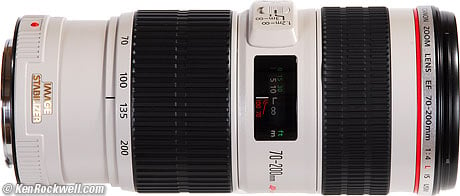Canon 70-200mm f/4 L IS
© 2007
KenRockwell.com
Canon EF 70-200mm f/4 IS. enlarge
I got mine here. Here and here are also excellent. It helps me keep adding to this site when you get yours from these links, too.
August 2007
Back to the top of my Canon 70-200mm f/4 L IS Review
Back to where you were in the Performance section
Sharpness is fantastic. The Canon 70-200mm f/4L IS is the sharpest zoom I've ever used.
Other Canon zooms, like the huge 70-200mm f/2.8 IS are as good, but the sample I tried had been dropped off an elephant so it was soft on one side.
Other lenses like my Nikon 80-200mm f/2.8 AF-S may be as sharp in a lab, but they lack IS, so they're softer in real world hand-held use.
The Nikon 70-200mm f/2.8 VR probably is as good, but since Nikon makes no full-frame digital cameras I can't get the same performance from it as I get from my 70-200mm f/4 IS on my full frame Canon 5D. (If you're on a 1.6x camera they ought to be the same.)
Other Canon 70-200mm L zooms without IS that haven't been dropped are probably as sharp in a lab, but IS is critical for sharp hand-held shots in the real world.
Lenses like this 70-200mm f/4L IS are so good that they force you to go make good photos, because they have no defects on which weak photographers love to blame their bad results. There is no sharper zoom to which to aspire; this is it.
Many of the Canon tele zooms I've borrowed to review from friends or bought used, like my 20 year old 70-210mm f/4, have been softer on one side as I've noted in their reviews. God only knows what people do to their lenses, and thankfully this softness is only visible in deliberate tests, but my new 70-200mm f/4L IS is perfect. I bought mine from Adorama in New York City.
My Canon 70-200mm f/4 L IS is so good it doesn't need to be stopped down. Look at the crops from 100% full-frame images above at color fringing. Those were shot wide open at f/4! If you printed those images at 44" (1.1m) wide, that's exactly what you'd see. It's simply amazing.
The reason the Canon 70-200mm f/4 L IS is so ridiculously sharp is many decades of innovation. Mid-range tele zooms have always been the easiest to design and manufacture, so they are the first zooms to have appeared in the 1960s and 1970s. Canon and everyone has more experience making these than any other kind of zoom. Heck, Canon makes FOUR different 70-200mm L-series zooms today!
For most 70-200mm lenses, 12 elements is plenty. My Canon 70-200mm f/4 L IS uses twenty, including some of fluorite and UD glass, so Canon is pulling out all the stops to make this the very best that they can. Twenty elements is more like a $250,000 Panavision Primo Zoom than a still camera lens.
Since I've shown how good the far corners are on full frame above, let me show the center here.
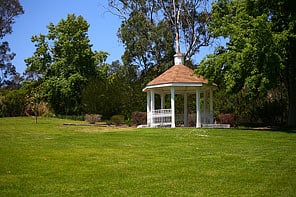 |
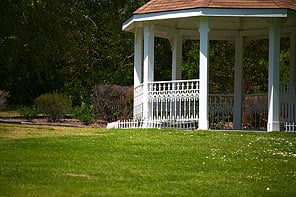 |
At 70mm, full image, full-frame 5D |
At 200mm, full image, full-frame 5D |
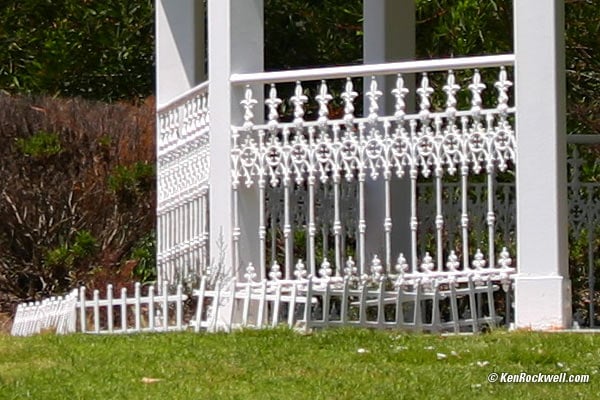
100% crop from 5D, Canon 70-200mm f/4 L IS at f/4 at 70mm.
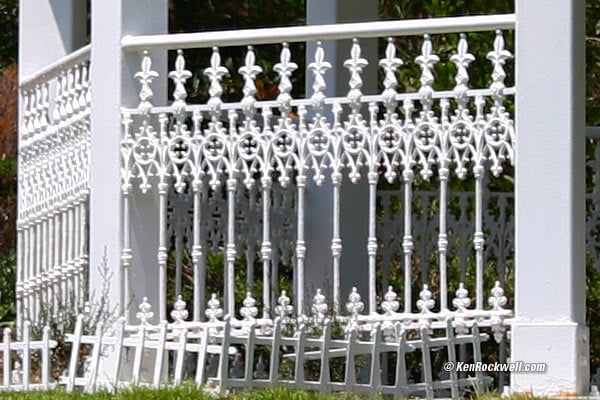
100% crop from 5D, Canon 70-200mm f/4 L IS at f/4 at 100mm.
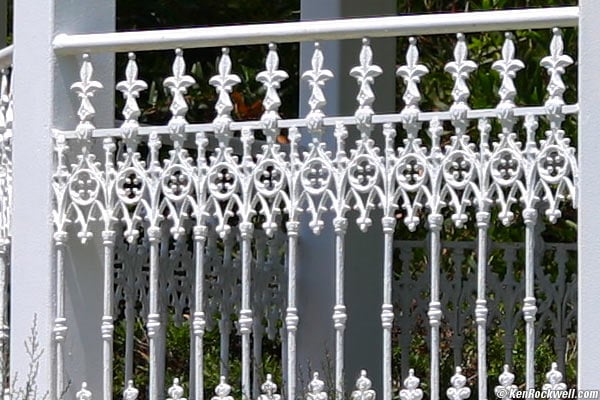
\100% crop from 5D, Canon 70-200mm f/4 L IS at f/4 at 135mm.
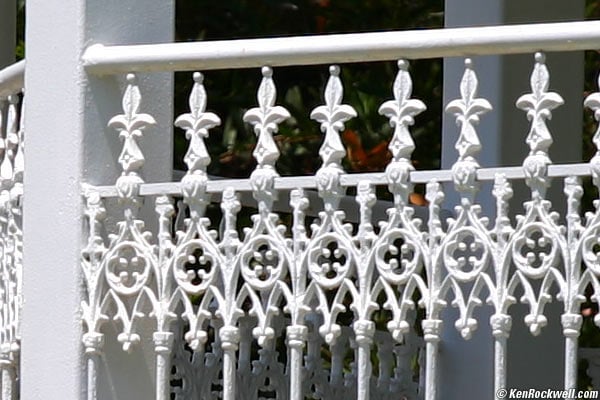
100% crop from 5D, Canon 70-200mm f/4 L IS at f/4 at 200mm.
This is as good as lenses get. Print the complete image at this magnification and the print will be 44" (1.1m) wide. These are hand-held, of course, and these do get a little sharper at f/5.6 but I'm too lazy to add examples.
Diffraction is usually the sharpness-limiting factor for all lenses, especially digital SLRs, at about f/11 and above. See also How Sharpness Varies with Aperture.
Back to the top of my Canon 70-200mm f/4 L IS Review
Back to where you were in the Performance section
Back to the top of my Canon 70-200mm f/4 L IS Review
Back to where you were in the Performance section
The Canon 70-200mm f/4 L IS' image stabilization works great. I get perfectly sharp shots 50% of the time at 1/8 of a second throughout most of the zoom range. Perfectly sharp means perfect tripod-equivalent sharpness as seen at 100%. At normal magnifications you can get perfect results at much slower speeds.
Read Why IS is Important to understand more about what these ratings mean.
Here are the results of my research with about 1,000 shots:
Percent perfectly sharp shots, Canon 70-200mm f/4 L IS on a 5D with IS OFF
1 |
1/2 |
1/4 |
1/8 |
1/15 |
1/30 |
1/60 |
1/125 |
|
70mm |
0 |
27 |
33 |
83 |
100 |
|||
100mm |
0 |
5 |
40 |
83 |
100 |
|||
135mm |
5 |
38 |
67 |
100 |
||||
200mm |
0 |
3 |
5 |
70 |
Percent perfectly sharp shots, Canon 70-200mm f/4 L IS on a 5D with IS ON
1 |
1/2 |
1/4 |
1/8 |
1/15 |
1/30 |
1/60 |
1/125 |
|
70mm |
10 |
20 |
80 |
80 |
100 |
100 |
100 |
100 |
100mm |
0 |
33 |
50 |
100 |
100 |
100 |
100 |
|
135mm |
20 |
33 |
50 |
60 |
100 |
100 |
100 |
|
200mm |
0 |
20 |
50 |
50 |
83 |
83 |
100 |
Let's chart the slowest speed at which I get 50% of my shots perfectly sharp at each focal length, and with that, we can calculate how many stops we gain with IS.
"Real Stops Improvement" are how many extra stops I got, IS ON compared to IS OFF.
"Marketing Stops Improvement" isn't comparing the speed I can use from IS OFF to IS ON, but instead comparing the speed one can use with IS ON to the old-wives-tale speed of 1/focal length. That's called Lying with Statistics.
No IS |
IS |
Real |
Marketing Stops Improvement |
|
70mm |
1/40 |
1/3 |
3-2/3 |
4-1/2 |
100mm |
1/40 |
1/8 |
2-1/3 |
3-2/3 |
135mm |
1/40 |
1/8 |
2-1/3 |
4 |
200mm |
1/100 |
1/11 |
3-1/6 |
4-1/6 |
It's easy to get sharp shots at 1/10 second at 70mm.
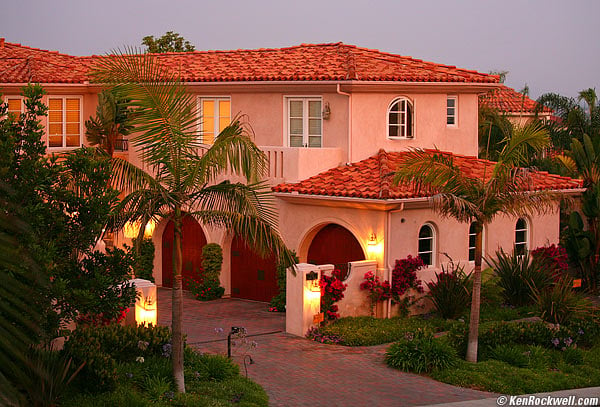
Canon 70-200mm f/4 IS hand-held 1/10 sec. at 70mm, twilight, 1.3x camera, ISO 400.

Canon 70-200mm f/4 IS hand-held at 1.2 seconds at 70mm, twilight, 5D at ISO 400.
For Internet sizes, even one-second exposures are no problem. I could have done better here. TIP: In dim light, fire several shots in the continuous shutter mode and pick the sharpest later. Blur is a random event, so if you fire enough shots, you'll eventually get a sharp one even at very slow speeds!
Percent perfectly sharp shots, Canon 70-200mm f/4 L IS on a Rebel XTi with IS ON
1 |
1/2 |
1/4 |
1/8 |
1/15 |
1/30 |
1/60 |
1/125 |
|
70mm |
0 |
10 |
30 |
50 |
87 |
100 |
100 |
100 |
100mm |
5 |
5 |
20 |
100 |
100 |
100 |
100 |
|
135mm |
0 |
40 |
15 |
70 |
100 |
60 |
100 |
|
200mm |
0 |
10 |
80 |
100 |
100 |
100 |
Noise
It sounds like something's running around inside as the stabilizer operates, and it clicks when starting and stopping. That's OK, since the insides are vibrating to counteract the motion of your hands.
Tripods
My Canon 70-200mm f/4 L IS is smart enough to know it's on a tripod and leave things alone if you leave the IS running, but you ought to turn IS off while on a tripod to save the batteries. The manual says IS reduces battery life by about 20%.
Mode 1 and Mode 2
Mode 1 is normal.
Mode 2 is only for tracking moving objects. Since I've admired Mercedes' R129 SL500/500SL ever since it came out in 1989, I'm honored that Canon chose to use an image of a woman enjoying this masterpiece to illustrate mode 2.
back to the top of my Canon 70-200mm f/4 L IS Review
Back to where you were in the Performance section
PLUG
If you find this as helpful as a book you might have had to buy or a workshop you may have had to take, feel free to help me continue helping everyone.
It also helps me keep adding to this site when you get your goodies through these links to Ritz, Amazon and Adorama. I use them and recommend them personally.
Thanks!
Ken
Caveat: The ads below come from a third party and I don't see or approve them. They are sent to your screen directly from a third party. They don't come from me or my site. See more at my Buying Advice page. Personally I get my goodies at Ritz, Amazon and Adorama.




